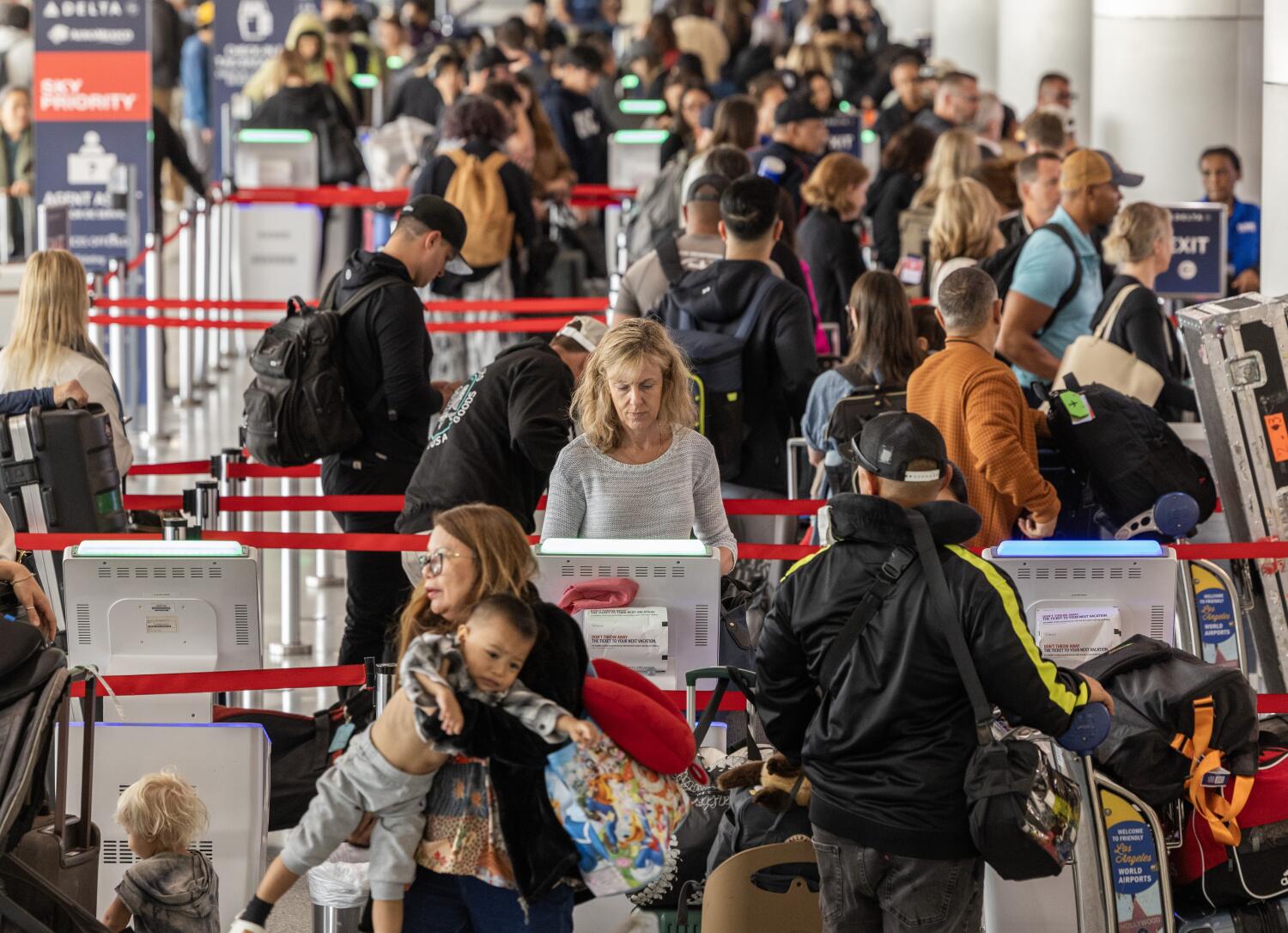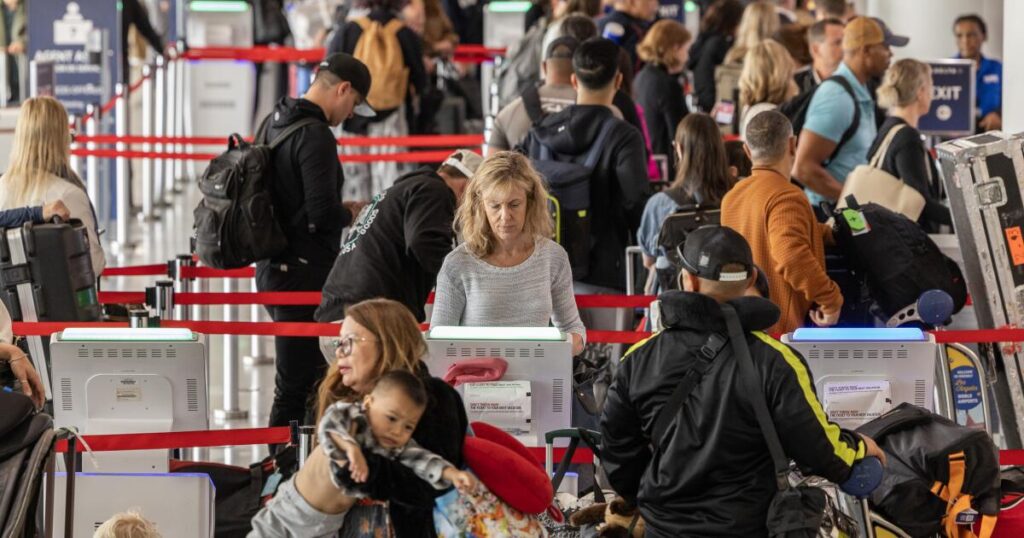
California’s summer COVID-19 season may be starting earlier than normal, with coronavirus concentrations in sewage rising in some areas along with positive test rates rising across the state.
The trend comes as the newest family of coronavirus subvariants, collectively known as FLiRT, are making significant progress across the country.
FLiRT subvariants (formally known as KP.2, KP.3 and KP.1.1) have replaced the dominant winter strain JN.1. Together they are estimated to have accounted for 50.4% of the country’s coronavirus infections in the two weeks starting May 12, up from 20% a month earlier.
California is not seeing a reduction in COVID-19 transmission as it did earlier this spring, and state health officials say they estimate transmission is now either stable or slowly increasing.
“Concentrations of COVID-19 in wastewater have increased in multiple areas of California since early May. The number of people testing positive for COVID-19 has been slowly increasing since May,” the state Department of Public Health told The Times on Friday. newspaper stated in a statement.
About 3.8% of COVID-19 tests came back positive in the seven days ending Monday; at the end of April, the rate was 1.9%. (The peak test positivity rate last summer was 12.8% in late August.)
Doctors at hospitals in Southern California and the San Francisco Bay Area are also seeing an increase in coronavirus transmission.
“We did see a small increase. That’s all due to the so-called FLiRT variant,” said Dr. Elizabeth Hudson, regional chief of infectious diseases at Kaiser Permanente Southern California.
So far, the increase has been primarily among outpatient cases at Kaiser Hospitals.
“Every time a new variant comes out, unfortunately, the new variant will be able to [overcome immunity resulting from prior infection]if someone hasn’t been vaccinated in a while, they’re obviously not going to get the same protection as someone who’s been vaccinated recently,” Hudson said.
In San Francisco, infectious disease doctors are noticing more and more people in hospitals with COVID-19.
Dr. Peter Chin-Hong, an infectious disease expert at the University of California, San Francisco, said, “The number of COVID-19 patients I see in the hospital exceeds my expectations.” While the number is small, “it’s definitely eye-catching.”
“We know it has gone up, and it went up earlier,” Chin-Hong said of coronavirus activity, based on his reading of wastewater data.
“Last year, I think prices started to go up at the end of June, and this year, it’s the end of May. So it’s a little early, but we’re starting from a very low place,” Chin-Hong said.
Interestingly, people in the Bay Area seem to be talking about the coronavirus more, Chin-Hong said. He recalled hearing a few days ago that someone’s child’s classroom was dealing with COVID-19 cases.
“It’s not necessarily a shocking number right now, but it’s… the start of summer, so that’s what we expected,” Chin-Hong said.
The Los Angeles County Department of Public Health also began to see a slight uptick in cases in recent days.
According to the latest data, there were an average of 82 to 92 COVID-19 cases per day between May 10 and 15, an increase from earlier in the spring. Los Angeles County health officials said in a statement to The Times that between March 25 and May 9, there were an average of 60 to 80 new cases per day. Case numbers generally reflect tests conducted in health care facilities and do not include home testing — and the statistics do not take into account infections among people who are not tested.
“It is too early to tell whether the modest increases in recent days will continue. These case numbers are low and it is difficult to assess true trends at this time,” the Los Angeles County Department of Public Health said.
Coronavirus levels in Los Angeles County wastewater have remained relatively stable, at 9% of last winter’s peak. But the data in these findings comes with a significant reporting lag, with the latest data available being for the 10 days ending May 11.
Virus levels in sewage are rising elsewhere in the state, including in Santa Clara County, Northern California’s most populous county and home to Silicon Valley. In recent weeks, coronavirus levels in Palo Alto’s sewers have reached the “high” threshold.
With the summer travel season about to officially begin over Memorial Day weekend, doctors are urging people to consider getting vaccinated in time — especially if they are at higher risk for serious complications from COVID-19.
In California, only 36% of people 65 and older have received an updated version of the COVID-19 vaccine first rolled out in September. The Centers for Disease Control and Prevention has urged everyone 6 months and older to get a dose of the updated vaccine. A second dose is also recommended for seniors 65 and older, as long as at least four months have passed since their last shot.
It is especially important that older adults receive at least one of the newer doses. Chin-Hong said among the patients he has seen recently with severe COVID-19, none of them had received a newer vaccine since September and were often over 75 or immunocompromised.
“We are still seeing hospitalizations, and more than 95% of hospitalizations have not received the updated 2023-2024 vaccine, according to data provided by the CDC in February,” the Los Angeles County Department of Public Health said. CDC data shows that compared with people who have not been vaccinated In comparison, protection against COVID-19 disease increased by 54% with the newer vaccine.
For seniors now considering a second, updated COVID-19 vaccination, factors to consider include travel plans or whether they have a job where they interact with multiple people, doctors say. There is plenty of time to get vaccinated now, with the new formulation expected in the fall.
“By getting a booster now, you can really give yourself protection to get through this possible summer surge,” Hudson said.
Although for many people, COVID-19 no longer means going to the hospital, “for some people, it is a big deal,” Jinhong said. “These are the people I see in the hospital – they are very sick and they have been there for a while.”
According to the Centers for Disease Control and Prevention (CDC), more than 43,000 people have died from COVID-19 across the country since early October, including more than 3,400 deaths in California. In comparison, the national death toll from influenza is likely to be smaller – an estimated 25,000 deaths during the same period.
According to the Los Angeles County Department of Public Health, patients hospitalized with COVID-19 are at a higher risk of death than those with the flu, especially older adults.
“When you’re in the hospital, a lot of other things can happen. … You can get a nosocomial infection. So you always want to avoid hospitalization,” Chin-Hong said.
California recently achieved a major COVID-19 milestone with zero daily deaths on April 2, a feat not achieved since day one of the pandemic. Deaths in Los Angeles County also hit a new low – a weekly average of 0.14 deaths per day during the seven-day period ending April 2.
“This is truly a victory for science, that we have reached the day where we have zero deaths from COVID-19,” said Hudson, who attributed that to factors such as the development and training of vaccines and anti-COVID-19 drugs. .
Still, “COVID-19 is more than just the flu or a cold,” Hudson said. “COVID-19 can have very lasting effects on some people. … Long-term COVID-19 really makes things different.
Hudson said there is growing evidence that the more times you are infected with COVID-19, the greater the likelihood that it will persist long-term. “It does appear that people in their 30s and 40s are more likely to have long Covid.”
Some patients are permanently disabled by long-term COVID-19 infection, but “for most people, it seems — maybe 12 months later, sometimes 18 months later — all the symptoms are gone,” said Hudson. It’s too long and doesn’t feel good.
There has been talk about the long-term prevalence of COVID-19 being lower than the prevalence early in the pandemic. But even now, every time someone gets infected with COVID-19, there is still the possibility of long-term COVID-19 infection.
Some patients “have breathing problems,” Hudson said. Others may develop a condition called POTS, which stands for postural orthostatic tachycardia syndrome, which can cause a sharp increase in heart rate and dizziness.
“Long-term COVID-19 affects the autonomic nervous system in ways that we don’t yet 100 percent understand,” Hudson said. “But we do know that people eventually develop this particular syndrome, and it can be life-changing.”
In addition to staying up to date on vaccinations, doctors offer the following tips for preparing for an expected increase in coronavirus transmission:
• Avoid sick people. Some patients may disguise their symptoms as a “cold,” but it may actually be the beginning of COVID-19 illness.
• Get tested to see if you are sick, and get tested every day. Sometimes it takes longer after illness onset for a rapid COVID-19 test to show a positive result. Consider taking a rapid COVID-19 test every day for three to five days after you develop cough and cold symptoms, Hudson said. Doing so can help sick people take steps to isolate themselves and limit the spread of the disease to others.
• Make a plan to get help from Paxlovid if you become sick. Paxlovid is an antiviral drug that can reduce the risk of hospitalization and death when taken by people at risk for severe COVID-19 who have mild to moderate illness.
• Today, masks are no longer common, but they are still a handy tool to prevent infection. On a crowded flight where you are nearby someone who is coughing, wearing a mask can help reduce the risk of infection.

